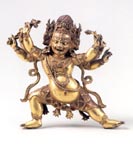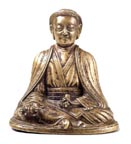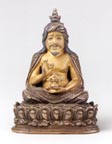| Preface The Collector  I have been asked by the learned authors of this catalogue to write a few words to serve as a preface to their scholarly work and as an explanation of the 'raison d'etre' of the Nyingjei Lam Collection or, to put it simply, to explain what it was that first prompted a Roman Catholic of Irish-American origin who has spent most of his life living among the Chinese to begin collecting 'Tibetan Buddhist and related art'. As those familiar with theTibetan language know, 'Nyingjei Lam' means 'the Path of Compassion' or 'the Compassionate Path'. Looking back twenty years ago to when I began to form the Nyingjei Lam Collection, I realize that it was a combination of things that drew me towards Tibetan Buddhist and related art. The first and perhaps the most compelling of these was the compassionate smiles that radiated from the faces of many of the statues of Buddhas, Bodhisattvas, saints and lamas that I saw. To me, these were not foolish, empty smiles, but rather smiles that reflected an inner freedom, peace and joy, while also bringing peace and joy to the hearts and minds of their beholders.
Perhaps the second thing which drew me towards Tibetan Buddhist and related art was an I should like to dedicate this book firstly to His Holiness the Dalai Lama, the Hope, the Guide and Succour of the Tibetan People; secondly, to India, Tibet's greatest, most generous and most enduring friend who not only in ancient times shared with her northerly neighbour her blessed wisdom and path of compassion, but who also, in more recent times, though herself heavily burdened, opened wide her loving arms to welcome and embrace the thousands upon thousands of destitute Tibetan refugees who came seeking a home in exile where they could preserve their faith and culture intact and pass it on to future generations; and thirdly, to Dr Pratapaditya Pal, who, through his many scholarly yet very readable works on Tibetan and related Buddhist art, was my earliest and foremost teacher and who has done more than any living person to make Tibetan art known to the modern world. I am also extremely grateful to Dr Andrew Topsfield of the Ashmolean Museum for his great help and encouragement, I regard it as a singular honour that the Nyingjei Lam Collection is being exhibited at the Ashmolean Museum, Oxford, one of the most ancient and venerable universities in Christendom. I should also like to thank George Ortiz, a humanist, and a distinguished collector and lover of antiquities, who has given good advice and help and who lovingly spent several long days, together with David Weldon, giving the contents of the Nyingjei Lam Collection a 'good dusting' after their arrival at Oxford. This collection could not have been formed in its present state had it not been for the frequent and No words are adequate to express the thanks that I owe to Simon Lee and Eva Chan, the unofficial 'curators' of the Collection, both of whom have over the years done all in their power to help me in my collecting endeavours. I should also like to thank the many Tibetans who have extended their friendship to me and have helped me in many ways over the years. I should especially like to thank my Tibetan teacher, Sonam Palden, and Lithang Phulu, my mentor in all things pertaining to Tibet and Tibetan art, and his son Thupten for his constant advice and help. For the wonderful Tibetan translation of parts of this catalogue, I owe a great debt of gratitude to Choephel Thupten and theVenerable Geshe Lhakdor. Finally, I sincerely hope that those who come to view the Nyingjei Lam Collection will not regard the objects herein as mere metal, wooden or stone artifacts, but will rather see in each a tangible manifestation of the religious spirit of the Tibetan people and of the quality that they most cherish, compassion. |




